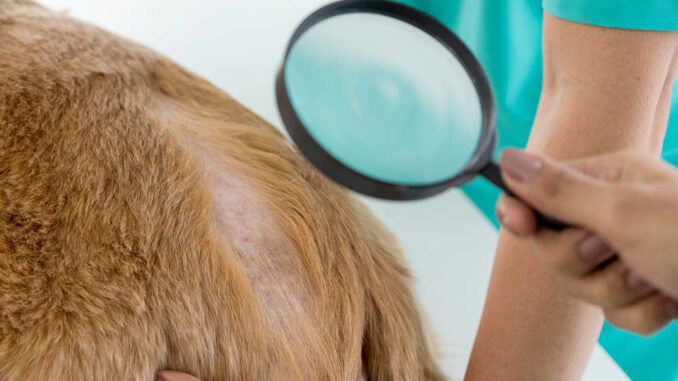
This article was updated on February 7th, 2024

One common problem we often encounter as veterinarians is the presence of scabs (serous crusts) on a dog’s skin. Scabs on dogs can be the sign of an underlying health problem, such as an infection or allergy, so it is important to understand the potential causes and discuss the situation with your veterinarian. In this article, our veterinarians Dr. Whittenburg & Dr. Crow share the common causes of scabs in dogs with pictures.
1. Scabs from minor wounds usually heal in 1-2 weeks
“Most scabs from minor wounds or injuries heal by themselves within a couple of weeks (depending on the size and severity of the injury). Scabs are great protectors of the wound, and it’s best to let them heal without any additional medication.”
If your dog’s scabs are due to an injury, read our article about Wound Healing in Dogs.
2. Scabs taking longer to heal are likely caused by a medical issue like a skin infection or allergy
If your dog suddenly develops scabs without any obvious injury, it may indicate an underlying medical issue that needs veterinary treatment. Dr. Crow explains:
“Scabs on dogs can also be caused by health issues such as skin infections or allergies. If there is any health issue at play, the scab may take much longer to heal (if at all) or even get worse without the proper care. Therefore, scabs that lasts for weeks should be examined by your veterinarian to make sure you are treating the underlying medical issue before it gets worse.”
3. Top causes of scabs (with pictures)
As mentioned, medical issues, such as allergies, skin infections, and parasites, are the most common culprits of long-lasting scabs. Let’s go over each one (with pictures):
1. Allergies
Dogs with allergy issues also often exhibit excessive itching, scratching, and paw chewing due to skin irritation. Excessive scratching and irritation can lead to hair loss and scabs, as shown on the pictures below.
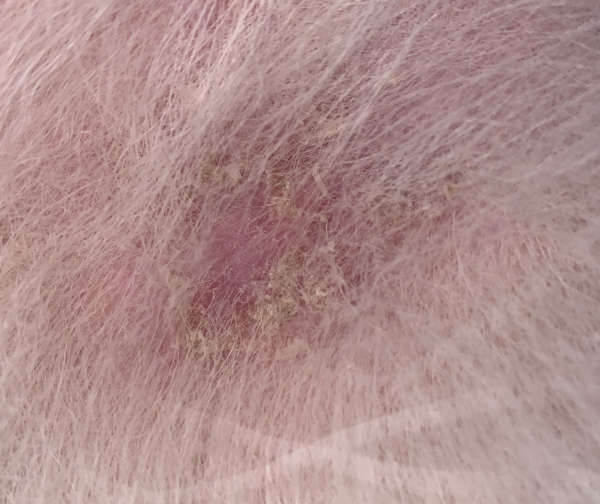
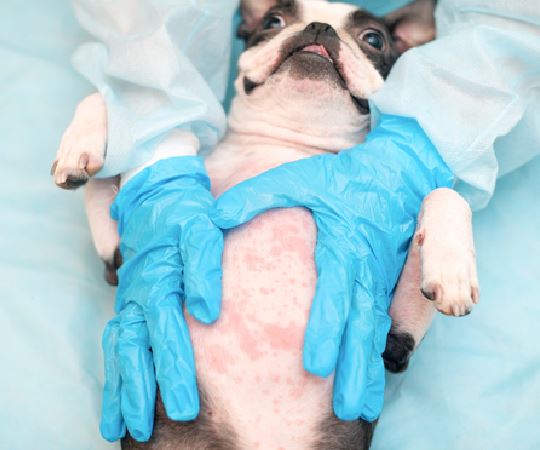
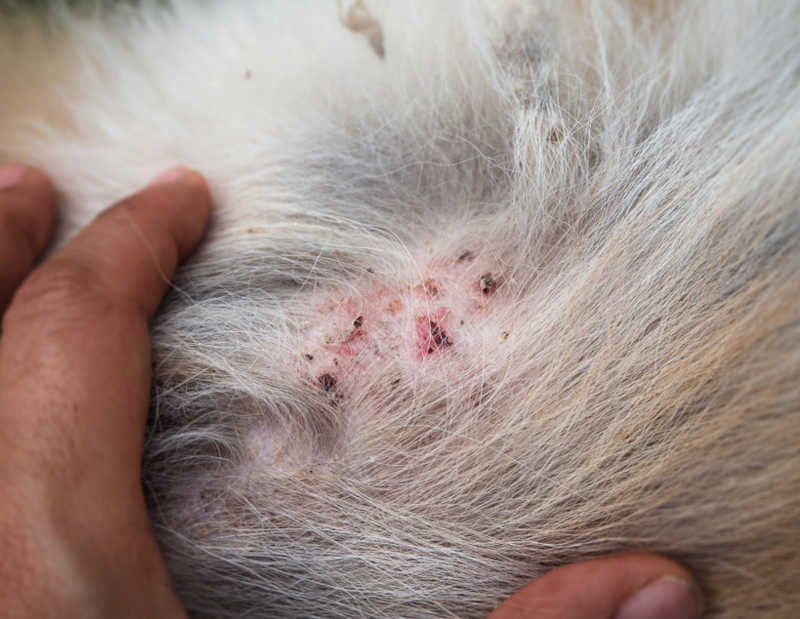
“Allergies are very common in dogs: we see an average of 10 dogs a week with allergies in our veterinary practice. Dogs can develop allergies to a wide range of things, including pollen, mold, dust mites, fleas, and certain foods. Allergies can cause the skin to become red, flaky, thickened, and itchy.”
To treat allergy-related issues, you must first control the underlying allergy. This can be accomplished in many ways, for example with allergy prevention medications, shampoos, wipes, and diet or environment changes. If a secondary skin infection is present, appropriate medication will be needed to treat the infection.
Learn more: Skin Allergies and Scabs
2. Bacterial skin infections
Scabs form over irritated and compromised skin and serve as protection from bacteria and infection, similar to a band-aid. Bacterial infections often cause redness, whiteheads (pustules), flakes and scabs, as shown in the pictures below.
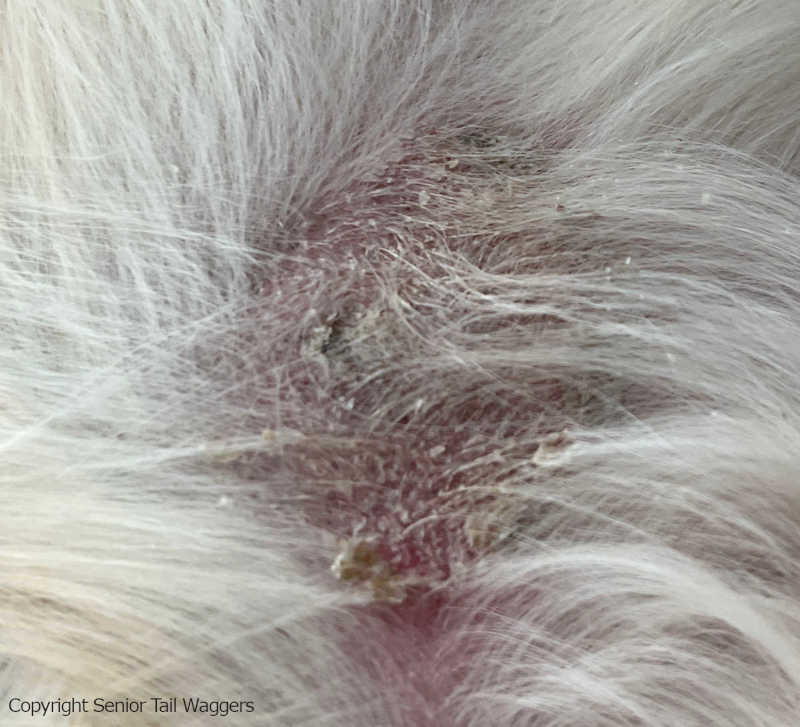
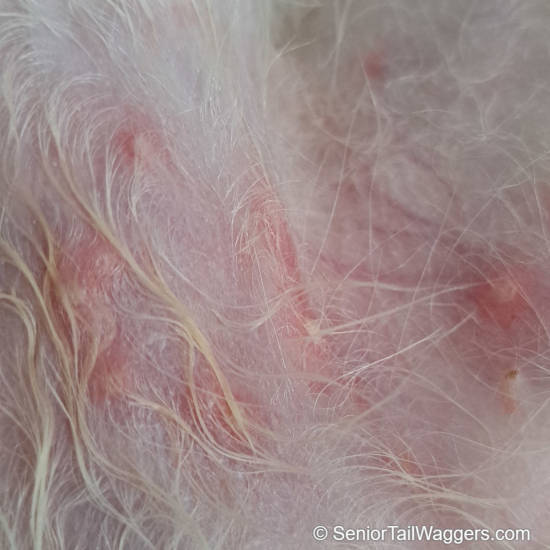
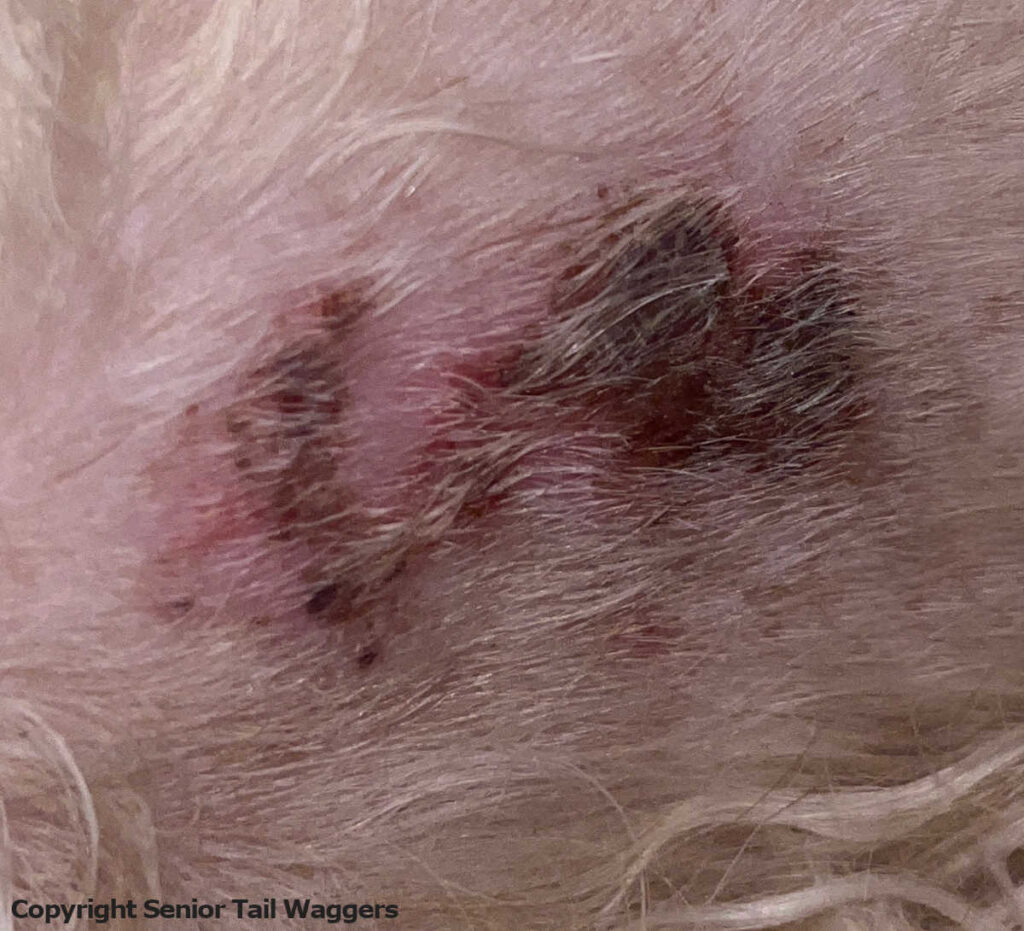
You may also notice your dog itching, chewing, or excessively licking. Antibiotics are often necessary to cure bacterial skin infections. Medicated shampoos, sprays, or ointments may also be prescribed.
With bacterial infections, there is also usually inflammation of the hair follicle called folliculitis. This can lead to the build-up of crusts (scabs form). There may be small bumps (papules), raised hairs (tufted papules) and hair loss. Learn more about bacterial skin infections or folliculitis.
3. Yeast Infections
Dogs can develop yeast skin infections, which are characterized by a distinctive sour or musty odor, a scent often described as being like corn chips. A yeast skin infection can cause redness, itching, inflammation of the skin, and scabs.
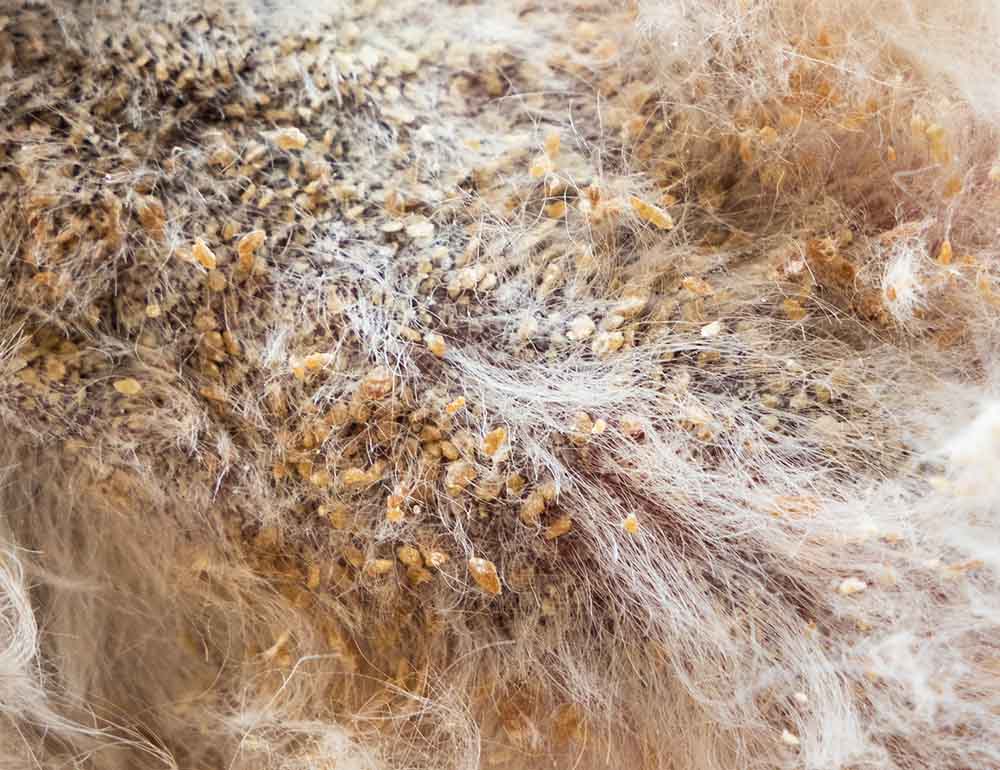
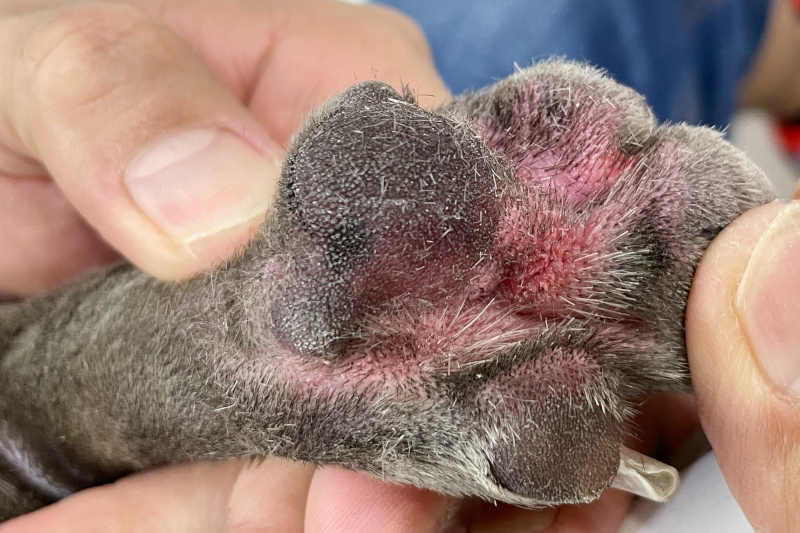
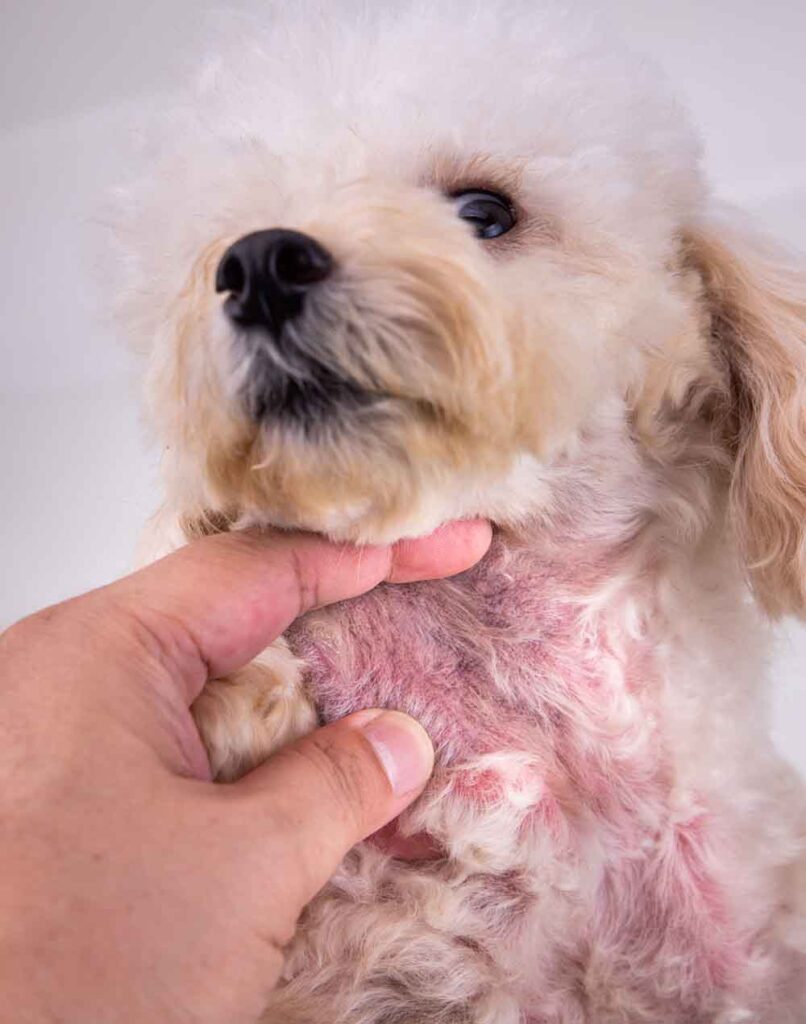
These infections may be found anywhere on the body but are especially prevalent in areas of high moisture and little light (ears, skin folds, between the digits, groin, underarms). Yeast infections are treated with oral antifungals, shampoos, powders, and creams.
Learn more about Yeast Infections.
4. “Hot Spots” infections
As the name suggests, hot spots are specific, isolated, inflamed, and moist areas of your dog’s skin, as shown in the pictures below. They most commonly form due to scratching and self-trauma resulting from bacterial infections, insect bites, or allergies. Hot spots are treated with both oral and topical medications, depending on the underlying cause.
Learn more about Hot Spots.
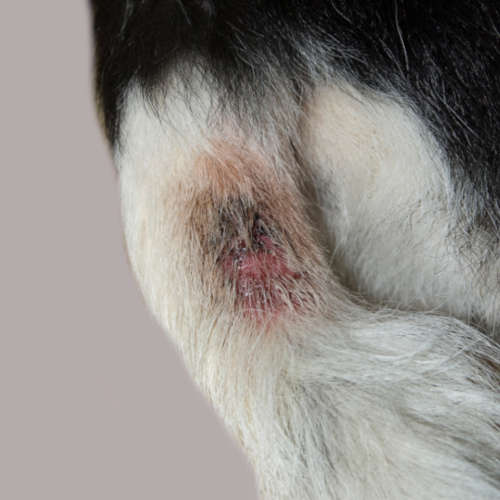
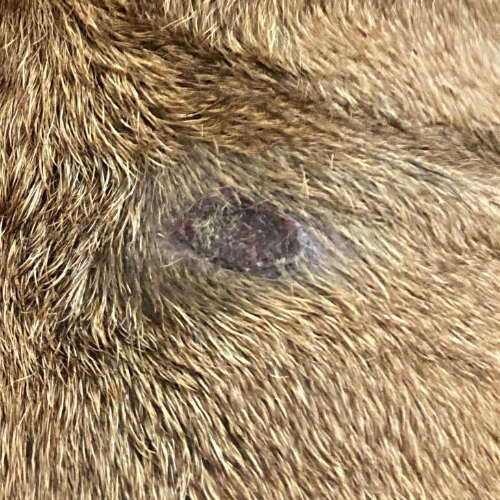
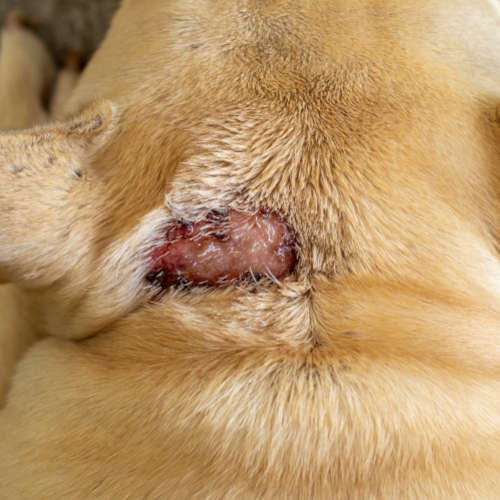
5. Ringworm
Despite being named after a worm, ringworm is actually caused by a fungus. It infects the skin in circular lesions resulting in scabs, soreness, and hair loss, as shown in the pictures below. It is an infection that can spread quickly and even pass to humans.
Learn more about Ringworm.
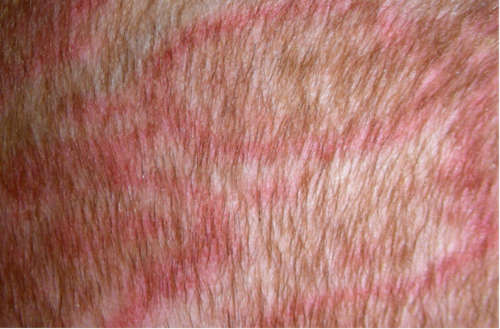
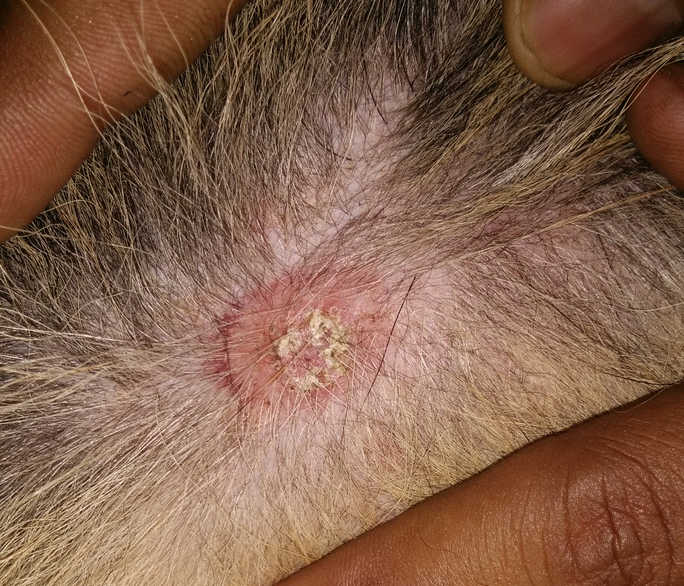
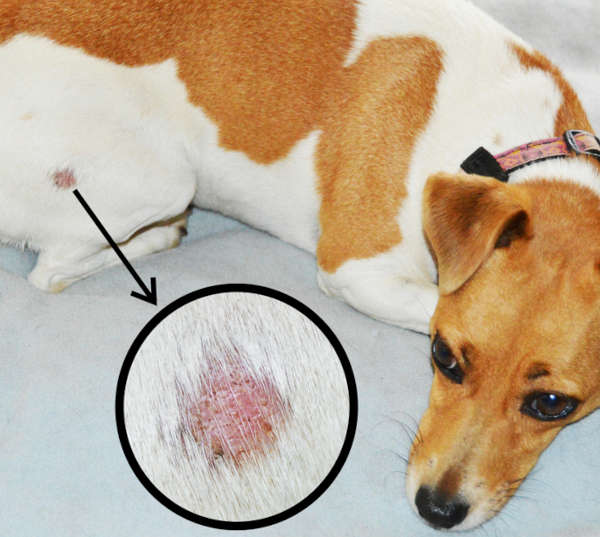
6. Mites
Mites are microscopic parasites (under 1mm in length) that can affect your dog’s skin and cause intense itching, discomfort, crusty and scaly skin, and hair loss.
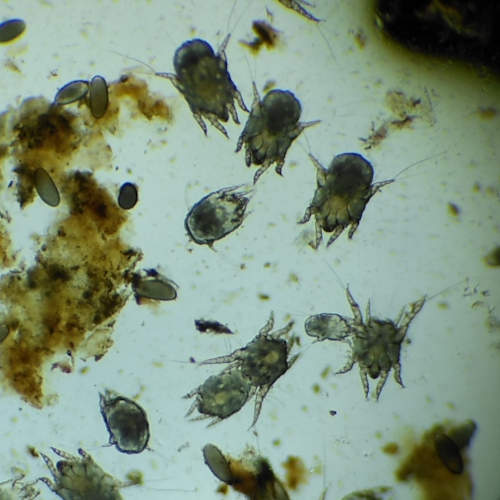
When these mites proliferate and cause skin irritation, it leads to a condition known as mange. There are two main types of mange in dogs: demodectic and sarcoptic mange.
Demodectic Mange primarily affects young, old, pregnant, and immunocompromised dogs (e.g., chemotherapy, corticosteroids, oclacitinib-Apoquel®). It is not always itchy. These dogs lose hair, typically beginning around the eyes. However, they usually do not scratch at them or form scabs.
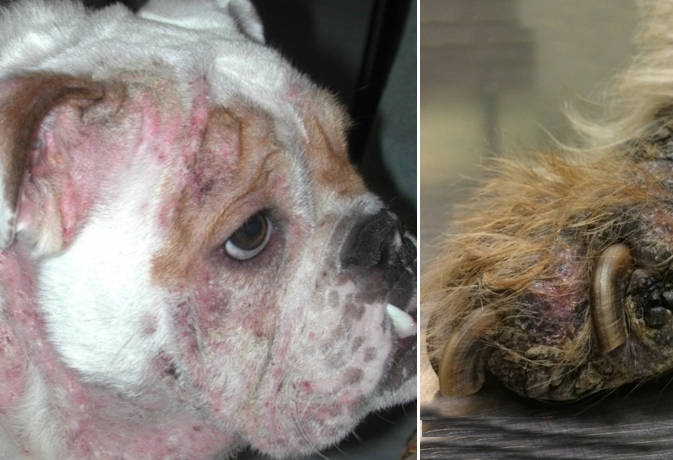
© Ian Brett Spiegel VMD, MHS, DACVD
Sarcoptic mange (scabies) is a mite infestation that is contagious and acquired through contact with the mites in the environment or from another host (e.g., fox, coyote, wolf, other dog). These infestations are very itchy, and excessive scabbing of the skin is common. The most common areas affected are the ear flaps (margin), elbows, and hocks (ankles).
Learn more about Scabies.
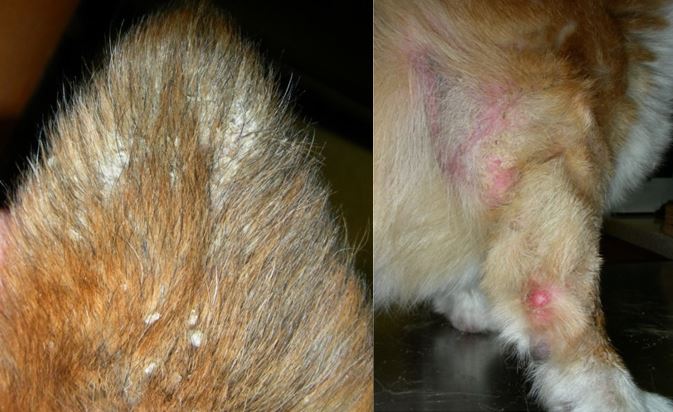
© Ian Brett Spiegel VMD, MHS, DACVD
7. Fleas & allergies to fleas
Fleas are hard to spot, but their droppings (flea excrement) can usually be spotted in a dog’s coat. Dogs infected with fleas, ticks, or lice will typically excessively lick, scratch, or even have scabs or hot spots (learn the best ways to tell if your dog has fleas). Some dogs experience an allergic reaction to flea saliva, which can cause inflammation, redness, and scabbing, often in the area near the tail.
Learn more about Flea Scabs.
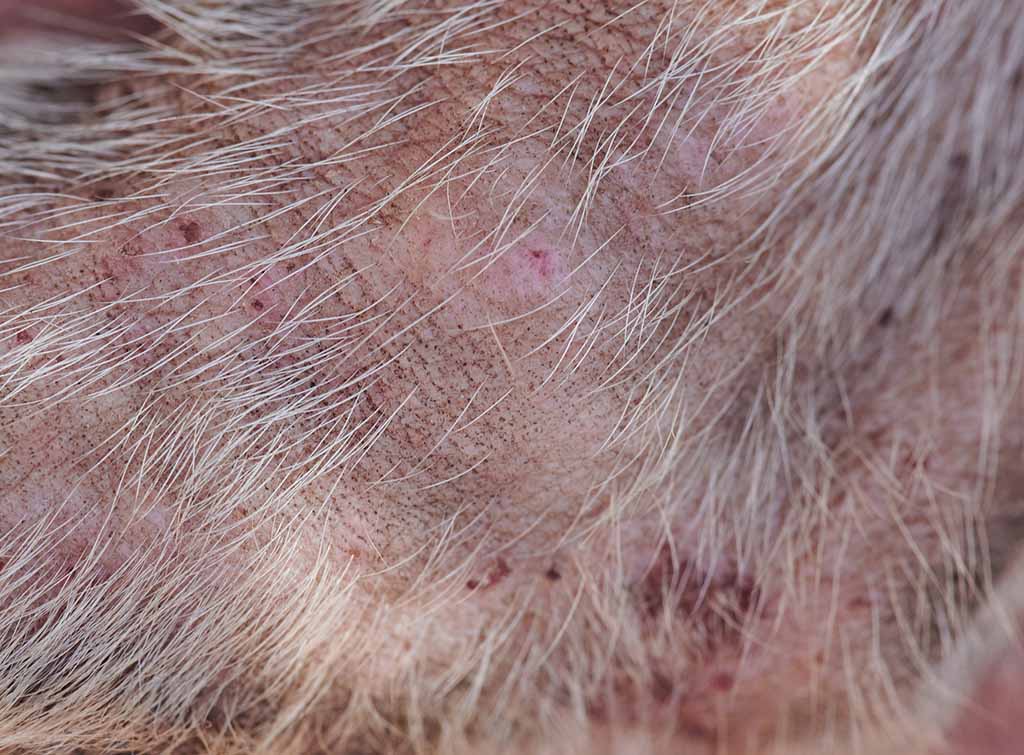
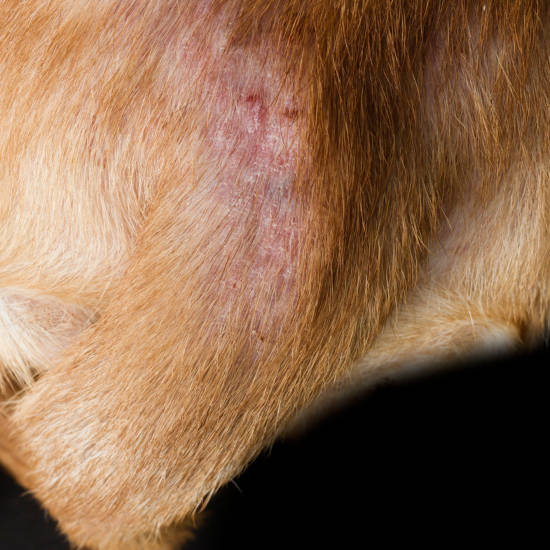
Other potential causes
There are numerous other issues that may cause scabs, including autoimmune disorders, hormone imbalances, and nutritional issues. If your dog is forming scabs without trauma (injury), they should be evaluated by their vet ASAP.
4. Most scabs from injuries heal on their own, but persistent scabs may require prescription medication
Owners often ask us if there is any medicine that can help with scabs. In general, scabs from injuries should be left alone to heal: they are marvelous wound protectors and do not need additional medications to do their job.
However, as we have discussed, multiple scabs can be an indication of an underlying health problem, such as a skin infection or an allergy. In these cases, your veterinarian may prescribe a topical or systemic antibiotic to treat the underlying condition.
5. Take your dog to the vet if you see sudden changes in your dog’s skin, or if your dog starts scratching or licking a lot
A veterinarian should have a look at your dog ASAP if you see any of the following (in addition to scabs):
- Significant changes in your dog’s skin
- Sudden appearance of sinister-looking lesions (scabs on dogs should be monitored to make sure they don’t evolve into something more serious)
- Areas causing your dog a lot of discomfort or resulting in excessive scratching or licking
It’s also important to pay attention to your dog’s overall well-being. If your dog is acting differently or seems unwell, you should call your veterinarian.
6. The location of the scab may help identify the issue
The location may tell you a bit more about what your dog may be suffering from. For example, if your dog has scabbing on their nose, it could be due to a dry nose (hyperkeratosis). Read our articles about the most common scabs in dogs by location:
Frequently asked questions
What if my dog has scabs and flaky skin?
Often, flaky skin is nothing to worry about. Just like humans, dogs can get flaky skin. Giving your dog fatty acid supplements or using moisturizing shampoo may help.
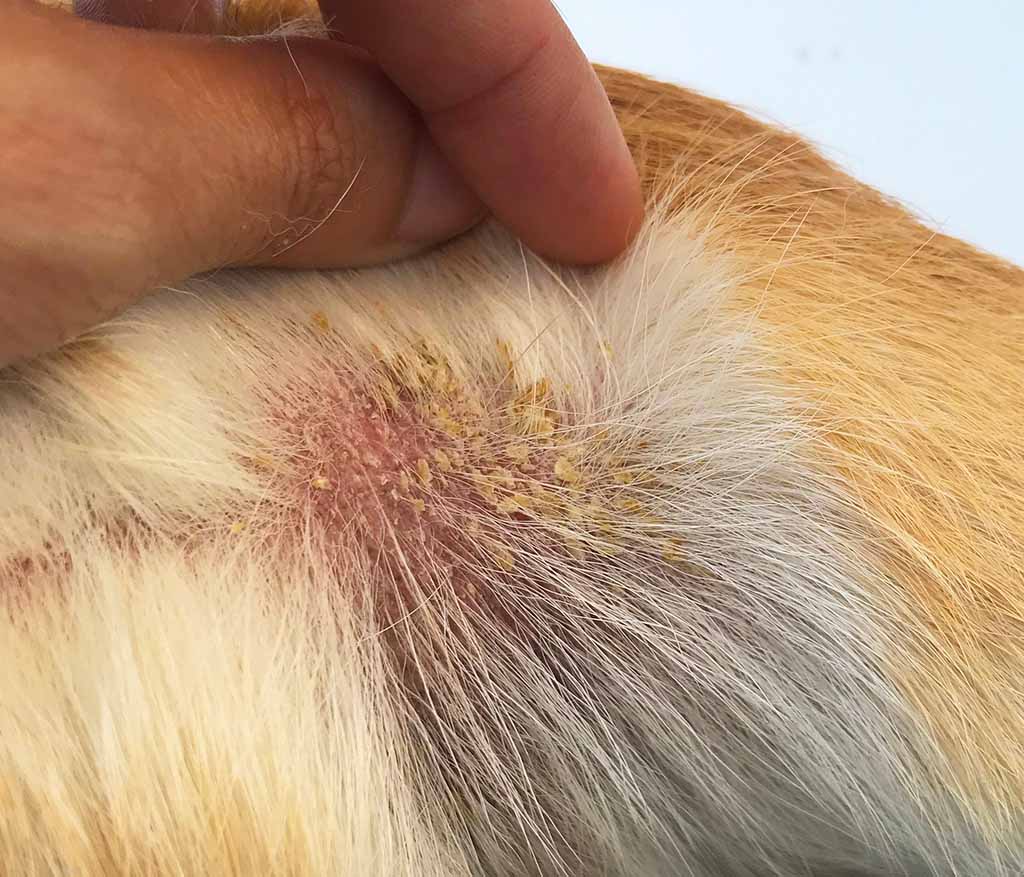
However, flaky skin can also be an indication of something more serious going on with your dog, including allergies, hypothyroidism, autoimmune disorders, and other skin conditions. If flaky skin persists, makes your dog uncomfortable, or if you observe other symptoms such as hair loss, consult your veterinarian.
What are scabs, and how do they form?
Scabs are bumpy and dry protective formations (crusts) that develop over a sore during the healing process. The scab starts to form as soon as the skin is injured. Cells found in the blood (known as platelets) gather at the break in the skin and clump together.
This clump is the foundation of a blood clot, which aids in halting the bleeding. When a clot dries, it becomes a scab. Platelets then work to form a more permanent clot while the injury heals.
In other words, when exposed to air, platelets break apart and form thread-like structures. These threads then form a web-like mesh that traps any red blood cells from escaping the wound. A scab forms when this mix of the mesh and red blood cells dries.
Scabs are typically reddish-brown in color and may be found anywhere on the skin. The size of the scab will vary and will correlate to the size of the injury.
Scabs are usually dry and rough on the surface, and moist below the surface. Scabs form to serve as protection from bacteria and infection, like a band-aid.
Where do scabs on dogs appear most frequently?
Scabs appear anywhere on the skin where there has been a trauma that breaks the skin barrier. These injuries can range from superficial to severe.
Because scabs can be the result of self-inflicting trauma (excoriations), the most common areas to find scabs are those that the dog can reach with their claws or paws. These scabs result from self-trauma (scratching and licking) and typically have an underlying cause such as an infection or allergy.
The back, chest, and under the ears are common areas for scabs. Injuries such as cuts and scrapes can be found anywhere.
What are the top causes of scabs due to injuries?
1. Cuts and scrapes: Like humans, dogs can sustain injuries to their skin, such as cuts and scrapes, resulting in a scab. If the injury is superficial and not infected, most of these will heal on their own. More significant cuts may need to be stitched, and any injury that gets infected will need to be seen by a veterinarian.
2. Self-trauma: The second most common reason for scabs in dogs is self-trauma. These scabs form after a dog has scratched or licked itself aggressively. If your pet is experiencing these issues, the underlying cause needs to be treated. Some issues that may cause a dog to scratch excessively include:
- Environmental allergies
- Food allergies
- Skin infections
- Ear infections
- Parasites (fleas, ticks, mites, etc)
Understanding each of these potential reasons can help you find the proper treatment.
Read more about common dog skin issues:
21 Common Dog Skin Problems [with Veterinarian Advice]
- All skin problems and conditions
- Lumps and bumps (and red lumps and bumps)
- Tumors, Warts, or Cysts
- Scabs or blood blisters
- Skin lesions or skin infections
- Cancerous lesions or lumps
- Skin allergies and rashes, heat rashes, hot spots
Related posts:
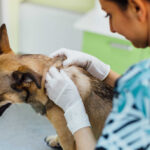 Crusty Scabs on Dogs: Top Causes and What To Do [Vet Advice] - Scabs serve as protective shields for injured skin, forming when skin is compromised, akin to a band-aid's role in human… [...]
Crusty Scabs on Dogs: Top Causes and What To Do [Vet Advice] - Scabs serve as protective shields for injured skin, forming when skin is compromised, akin to a band-aid's role in human… [...] Dog with Scabs & Losing Hair: Our Vet Explains What to Do - A dog losing hair in patches with scabs is a problem that many owners come to see us about at… [...]
Dog with Scabs & Losing Hair: Our Vet Explains What to Do - A dog losing hair in patches with scabs is a problem that many owners come to see us about at… [...] Black Scabs on Dog: Top Reasons & What to Do - The majority of black scabs will be insignificant and pose no threat to your dog. However, some black scabs could… [...]
Black Scabs on Dog: Top Reasons & What to Do - The majority of black scabs will be insignificant and pose no threat to your dog. However, some black scabs could… [...]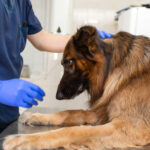 Scabs on Dog’s Head or Neck: Top Reasons [With Pictures] - Discovering scabs on your dog's body can be alarming, particularly when these scabs are on your dog's neck or head.… [...]
Scabs on Dog’s Head or Neck: Top Reasons [With Pictures] - Discovering scabs on your dog's body can be alarming, particularly when these scabs are on your dog's neck or head.… [...]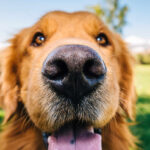 Dog Nose Scabs and Lumps [Pictures & Vet Advice] - Dogs use their nose and sense of smell to explore the world around them. As most owners know, dogs will… [...]
Dog Nose Scabs and Lumps [Pictures & Vet Advice] - Dogs use their nose and sense of smell to explore the world around them. As most owners know, dogs will… [...]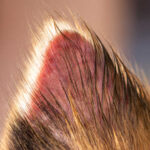 Dog Has Scabs On Ears: Top Causes & Vet Advice - In this article, our experienced veterinarian Dr. Chyrle Bonk walks you through common causes of scabs on a dog’s ears,… [...]
Dog Has Scabs On Ears: Top Causes & Vet Advice - In this article, our experienced veterinarian Dr. Chyrle Bonk walks you through common causes of scabs on a dog’s ears,… [...]Disclaimer: This website's content is not a substitute for veterinary care. Always consult with your veterinarian for healthcare decisions. Read More.




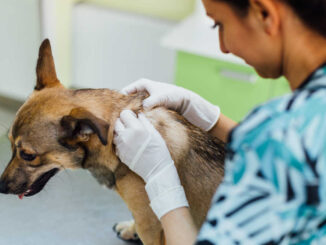

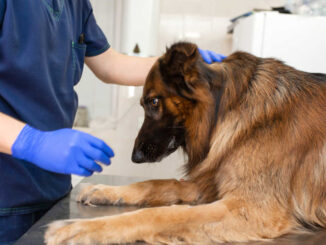
Pls refer some medicine so that i can help the poor stay dog 🐕 .dog is having a painful itching all the time since two days.
Take him to the vets no one can prescribe anything on here
Thank you for this informative post! I had no idea there could be so many reasons for scabs on my dog’s skin. The pictures really helped me understand what to look for. I’ll definitely be more vigilant and consider a vet visit if I notice any changes.
Thank you for this informative post! I was really worried when I noticed scabs on my dog’s skin. The pictures and explanations helped me understand the possible causes and what steps to take next. It’s great to know when to seek veterinary help. I appreciate the tips on at-home care as well!
Thank you for the detailed information and pictures! I had no idea that scabs could be caused by so many different issues. It’s really helpful to understand when to see a vet versus trying home care. I’ll definitely be keeping an eye on my pup now!
Thank you for sharing this informative post! The pictures are really helpful in identifying scabs on my dog. I was worried when I first noticed them, but your explanations and tips make me feel more confident about what to do next. I’ll definitely keep an eye on my pup and follow up with the vet if the scabs don’t improve.
Thank you for this informative post! I was really worried when I noticed scabs on my dog’s skin, but the photos and explanations were super helpful. I appreciate the tips on how to treat it and when to see a vet. Definitely feeling more at ease now!